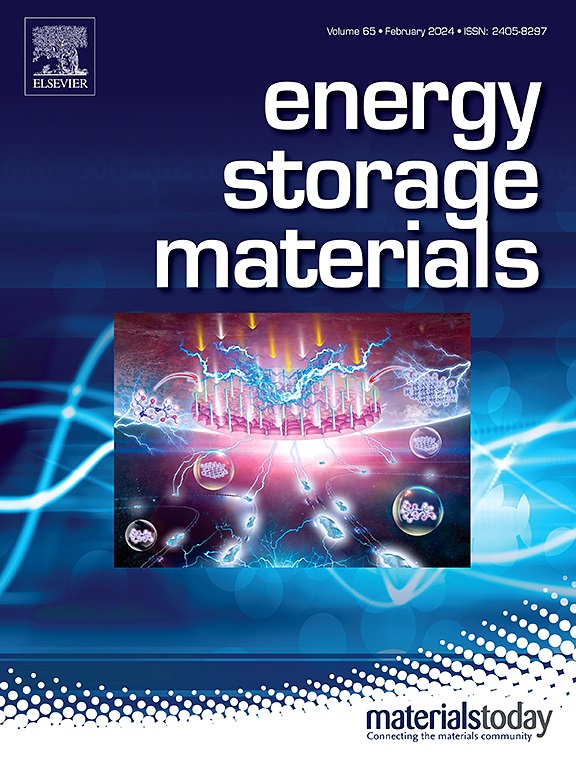Constructing Multiphase Junction towards Layer-structured Cathode Material for Enhanced Sodium ion Batteries
IF 18.9
1区 材料科学
Q1 CHEMISTRY, PHYSICAL
引用次数: 0
Abstract
The strategy of multiphase engineering has garnered significant interests due to the potential for achieving high energy density and long cycling lifespan towards layer-structured oxide cathode materials. However, challenges such as phase separation arising from different expansion coefficients among phases under high voltage or during prolonged cycling have been a concern. Bridging effect from a spinel phase was in-situ introduced herein via a target element quenching process. The introduced stabilized spinel-bridged phase can create a structural confinement between the O3 and P2 phases and realize interface reconstructing simultaneously by target-element optimization. Based on the experimental and computational results, the multiphase riveting-structured O3/spinel/P2 triphasic structure provides a structural constraint and alleviates the internal stress, which can suppress detrimental irreversible phase changes to enhance the structural reversibility and stability. Beneficial to the optimized ions high diffusion kinetics and lower diffusion barriers, the obtained O3/spinel/P2-Na0.98Ni0.3Cu0.1Ti0.05Mo0.05Mn0.5O2-δSδ demonstrates an impressive initial capacity of 178.6 mAh g-1 at a current density of 10 mA g-1, with a remarkable capacity retention rate of 86.65% over 200 cycles at 50 mA g-1. This innovative approach offers a new solution for preparing structurally stable, high-performance layer-structured oxides with satisfied cycling performance for sodium-ion batteries.增强型钠离子电池层状正极材料多相结的构建
多层结构氧化物正极材料具有实现高能量密度和长循环寿命的潜力,因此多相工程策略引起了人们的极大兴趣。然而,在高压下或长时间循环过程中,由于相间膨胀系数不同而引起的相分离等问题一直是人们关注的问题。本文通过靶元淬火工艺原位引入尖晶石相的桥接效应。引入的稳定尖晶石桥接相可以在O3和P2相之间形成结构约束,并通过靶元优化同时实现界面重构。实验和计算结果表明,O3/尖晶石/P2多相铆接结构提供了一种结构约束,减轻了内应力,抑制了有害的不可逆相变,增强了结构的可逆性和稳定性。优化得到的O3/尖晶石/P2-Na0.98Ni0.3Cu0.1Ti0.05Mo0.05Mn0.5O2-δSδ在10 mA g-1电流密度下的初始容量为178.6 mAh g-1,在50 mA g-1电流密度下的200次循环容量保持率为86.65%。这种创新的方法为制备结构稳定、高性能的层状结构氧化物提供了一种新的解决方案,并具有满意的钠离子电池循环性能。
本文章由计算机程序翻译,如有差异,请以英文原文为准。
求助全文
约1分钟内获得全文
求助全文
来源期刊

Energy Storage Materials
Materials Science-General Materials Science
CiteScore
33.00
自引率
5.90%
发文量
652
审稿时长
27 days
期刊介绍:
Energy Storage Materials is a global interdisciplinary journal dedicated to sharing scientific and technological advancements in materials and devices for advanced energy storage and related energy conversion, such as in metal-O2 batteries. The journal features comprehensive research articles, including full papers and short communications, as well as authoritative feature articles and reviews by leading experts in the field.
Energy Storage Materials covers a wide range of topics, including the synthesis, fabrication, structure, properties, performance, and technological applications of energy storage materials. Additionally, the journal explores strategies, policies, and developments in the field of energy storage materials and devices for sustainable energy.
Published papers are selected based on their scientific and technological significance, their ability to provide valuable new knowledge, and their relevance to the international research community.
 求助内容:
求助内容: 应助结果提醒方式:
应助结果提醒方式:


